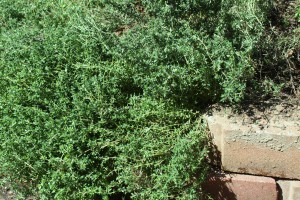Growing thyme is one of the herbs every herb lover want to grow. Thyme give many rewards and has a lots of uses, but it also looks good in the garden. Its low growing habit look great in walkways, rock gardens, trailing over walls, and as a ground cover to help repel weeds.
The common thyme’s Latin name T. vulgaris is an ever green shrub. Depending on the variety Thyme grows about 3-10 inches. The creeping varieties grow low to the ground.
Just a few of the over 350 varieties
- Broad leaf thyme
- Lemon thyme
- Wooly thyme
- Golden creeping thyme
- English thyme
- Lemon thyme
- Lavender thyme
- German thyme
- Camphor thyme
- Silver thyme
- Nutmeg thyme
- Caraway thyme
- Mother-of-Thyme
It is fun to grow as many varieties as possible. Try growing several in a thyme bed with a sundial set int the center of the bed.
Common thyme is upright with woody stems and about one foot in height. The leaves are dark green to grayish green and very aromatic.
All parts of this sweet aromatic thyme can be used in cooking, cosmetics, medicinal, cleaning and just because it look nice. When thyme flowers it looks wonderful in arrangements trailing over the side of the vase and the smell is tremendous.
Site: Full sun to partial shade. At least four hours of sun. The soil should be well drained, slightly alkaline with a soil pH of 6 to 6.7 and dislike wet feet.
Propagating: Can be grown from seeds if growing common variety. The method used for other varieties is either division, layers or cuttings.
Growing: This evergreen scrub like to grow in zones 5-9. Other areas should protect in the winter. Thyme’s flowers are loved by the bees and produce a wonderful honey with a unique flavor. The flowers come in shades of pink to purple depending on the variety.
Grow thyme for borders, to drape over walls, for low edgings. The creeping varieties such as wooly, snowdrift, English wild thyme, and golden creeping thyme are wonderful between stepping stones and used for weed control. This wonderful plant will spread some and will fill in the gaps.
Companions: Plant thyme with eggplants, cabbage, potatoes, and tomatoes. Help to repel cabbage worms. It is a perennial and you may not want to plant in the garden. Better to plant in pots near these garden vegetables.
Harvest: Cut stems anytime during the summer, but twice cut back hard leaving about 3 inches of the stems during growing season. The leaves will dry, freeze or are wonderful in herbal vinegars.
Drying: Thyme is easy to dry. The leaves should be left on stems for drying and one method is to tie a group of stems with a rubber band and place inside of a paper bag filled with holes and tie shut and hung up to dry. The holes are for circulation, use a hole punch and punch several holes.
Dehydrator makes short work of drying thyme. If you have a mesh liner use it for thyme. Once the leaves dry they sometimes come off the stems. You can store the thyme on the stems or strip.
Refrigerator drying: Place the thyme on paper towels and either place inside of paper bags or lay on trays. It takes a little longer to dry but works quite well.
Cooking: Along with parsley thyme is added to a bouquet garni. Culinary thyme add lots of flavor to all kinds of dishes, such as stocks, marinades, lamb, chicken, pork, sauces, dressing, soups, and vegetables, especially root vegetables. Begin by using a small amount, the flavor of thyme is quite strong. As an added bonus, thyme helps to digest fatty foods, it aids in digestion.
Tip: To use just the leaves, hold the cut end of the stem in your hands and slide your fingers up the stem to the top or tip of thyme, removing the leaves as you go. Some thyme taste better than others, culinary thyme included common thyme or lemon thyme.
Cleaning: Thyme makes a great cleaner especially if added to vinegars for products such as dish soaps, laundry detergent, and all purpose cleaners. It has powerful antibacterial properties. It is also used as an insect repellent.
Cosmetics: Use in bath sachets, deodorants, facial steams, hair rinses, and as an antiseptic in mouthwashes and toothpaste. Thyme is very fragrant and can be used in potpourri.
Medicinal: Aid in digestion, mix with honey for coughs, sore throats, and chest infections. Common thyme can be used in infusions, tinctures, syrups, and massage oils. It is an antiseptic, expectorant, antispasmodic, astringent, antimicrobial, diuretic, and might help to heal wounds. Avoid if pregnant.
Just a little history. Thyme is found on the sunny hills of the Mediterranean. The Greeks and Scots revered the plant and use it for bravery. In 17th century England’s Culpeper recommended thyme for handovers, coughs and melancholy. A cookbook from the 1600’s had a recipe using thyme and beer to overcome shyness.
Growing thyme is easy and finding new varieties can be quite an adventure.
Happy Gardening!


